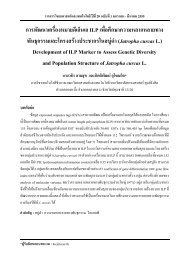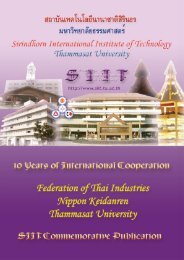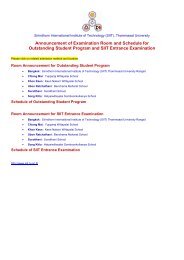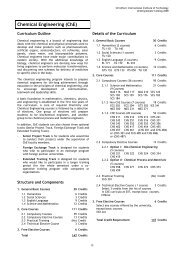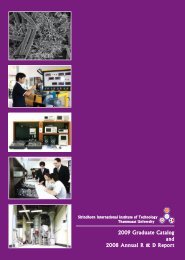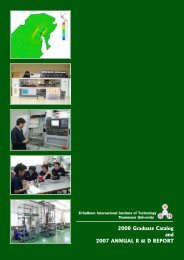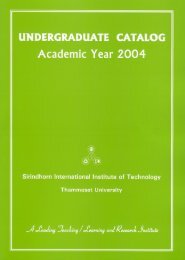2006 Graduate Catalog and 2005 Annual R & D Report - Sirindhorn ...
2006 Graduate Catalog and 2005 Annual R & D Report - Sirindhorn ...
2006 Graduate Catalog and 2005 Annual R & D Report - Sirindhorn ...
You also want an ePaper? Increase the reach of your titles
YUMPU automatically turns print PDFs into web optimized ePapers that Google loves.
<strong>2006</strong> <strong>Graduate</strong> <strong>Catalog</strong> <strong>and</strong> <strong>2005</strong> <strong>Annual</strong> R & D <strong>Report</strong><br />
<strong>Sirindhorn</strong> International Institute of Technology (SIIT)<br />
Research Interests:<br />
Electric Power Quality<br />
Electric power quality is a term which has emerged<br />
<strong>and</strong> attracted attention in electrical power engineering<br />
in recent years, because end-use equipment is more<br />
sensitive to disturbances that arise both on utility<br />
power systems <strong>and</strong> within customer facilities. Also,<br />
this equipment is more interconnected in networks<br />
<strong>and</strong> industrial processes so that the impacts of a<br />
problem related to electric power quality on any piece<br />
of equipment are much more severe. Therefore,<br />
underst<strong>and</strong>ing the performance of power systems is<br />
becoming more <strong>and</strong> more important. Attention to<br />
power quality is a joint user-utility responsibility. The<br />
power quality problems can be overcome by the<br />
efforts between utilities <strong>and</strong> customers with<br />
applications of power electronics such as active<br />
power filters, dynamic voltage restorers, etc.<br />
Active Power Filters<br />
With the proliferation of non-linear loads such as<br />
diode/thyristor rectifiers, non-sinusoidal currents<br />
(harmonic currents) are produced into power<br />
systems. These undesirable harmonics not only have<br />
deteriorated the power quality but also have induced<br />
the effect of interference in electronic circuits. The<br />
active power filters not only compensate for<br />
harmonics, but also compensate for reactive power,<br />
negative-sequence current, neutral current <strong>and</strong>/or<br />
flicker in the industrial power systems.<br />
Dynamic Voltage Restorers<br />
In many industrial processes, high power quality is<br />
essential for their proper operation. Although voltage<br />
sag only a few tenths of a second, it may result in<br />
disturbances with considerable costs due to loss of<br />
production. Voltage sags are caused either by faults<br />
<strong>and</strong> their clearance in the high voltage grid or by<br />
fluctuations of load especially in weak distribution<br />
networks.<br />
Dynamic Voltage Restorers (DVRs) correct for<br />
voltage sags <strong>and</strong> unexpected load changes:<br />
maintaining the voltage to sensitive loads within<br />
acceptable tolerances. The DVRs can improve<br />
process productivity <strong>and</strong> reduce significantly<br />
customer cost.<br />
Dr. Sawasd Tantaratana<br />
Professor<br />
B.E.E. with high distinction, University of Minnesota, USA<br />
M.S.E.E. Stanford University, USA<br />
Ph.D. in Electrical Engineering, Princeton University, USA<br />
Areas of Specialization: Communication systems, Spread-spectrum systems, Wireless communications,<br />
Signal processing, Digital filter design <strong>and</strong> realization.<br />
Research Insterests:<br />
Communication Systems<br />
Communication system design <strong>and</strong> analysis.<br />
Performance evaluation of communication systems in<br />
the presence of noise. Modulation techniques <strong>and</strong><br />
their performances. Signal detection, parameter<br />
estimation, <strong>and</strong> filtering.<br />
Wireless Communications <strong>and</strong> Spread-Spectrum<br />
Systems<br />
Spread-spectrum system design <strong>and</strong> analysis.<br />
Properties <strong>and</strong> performances of pseudo-noise (PN)<br />
sequences. Synchronization (acquisition <strong>and</strong> tracking)<br />
of PN signals. Code division multiple access (CDMA)<br />
<strong>and</strong> its applications. Multipath <strong>and</strong> fading effects in<br />
wireless systems. Optimum <strong>and</strong> sub-optimum CDMA<br />
receivers.<br />
Digital Signal Processing<br />
Signal <strong>and</strong> system analysis. Time-frequency signal<br />
analysis techniques. Digital filter, filter bank, <strong>and</strong><br />
multirate converter design, analysis, realization, <strong>and</strong><br />
applications. Techniques for simple realization <strong>and</strong><br />
implementation of digital signal processors.<br />
Dr. Toshiaki Kondo<br />
Lecturer<br />
B.Eng. in Mechanical Engineering, Tokyo Institute of Technology, Japan<br />
M.Eng. in Information Processing, Tokyo Institute of Technology, Japan<br />
M.Eng. in Image Processing, The University of Sydney, Australia<br />
Ph.D. in Image Processing, National University of Singapore, Singapore<br />
Areas of Specialization: Digital image processing, such as feature detection <strong>and</strong> segmentation in 2-D <strong>and</strong> 3-D.<br />
Computer vision, such as depth estimation <strong>and</strong> motion estimation. Pattern recognition, such as human face<br />
recognition.<br />
21




